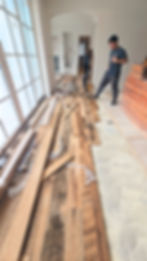Squeaks in Hardwood Floors
- Ruben Caicedo
- Feb 2, 2023
- 3 min read
Hardwood floors are a classic feature that can bring warmth and sophistication to any home. However, they come with their own set of peculiarities—none more perplexing and irritating than the enigmatic squeak that accompanies each step. Homeowners, builders, general contractors, architects, designers, and remodelers have all encountered this phenomenon, but what exactly causes that creak beneath our feet?

The Science Behind the Squeak
The origin of a hardwood floor squeak involves a delicate interplay between friction and movement. As you walk across the floor, your weight causes boards to rub against one another or against a nail that has loosened over time. These sounds can also occur when subfloor planks slide over the joists they are attached to. Each squeak serves as a small alert that something in the floor system is moving when it shouldn't be.
A typical wood floor system consists of several layers, and any of them can be responsible for the squeak:
Floorboards: Over time, wood dries out and shrinks, causing gaps to form between the boards. When stepped on, these boards may rub against each other or slide over nail shanks to generate a squeak.
Subfloor: The subfloor can become unglued from the joists or loosened from the nails or screws holding it down, creating up-and-down motion and noise.
Joists and Support Beams: Environmental fluctuations like humidity and temperature can cause wood joists and beams to twist and warp, leading to looseness and associated noises.
Nails and Fasteners: Nails can gradually pull out from the wood or bend due to the repeated stress of foot traffic, becoming less secure and more likely to squeak when they rub against the wood.
Adhesives Breaking Down: If glue was used in the installation of the hardwood floors and it begins to break down, the lack of adhesion can lead to increased movement and noise.

Seasonal Symphony
Changes in season bring about changes in humidity and temperature, which can drastically affect hardwood floors. During the humid months, wood absorbs moisture and swells, only to dry out and shrink as the air gets drier in colder seasons. This ongoing cycle can exacerbate the natural movement in the floorboards and contribute to the squeaking sounds.
Addressing the Acoustics
Squeaks can often be resolved without a full floor replacement. Solutions range from inserting shims into gaps, using specialized screws to secure loose boards from below, applying lubricant into the seams to reduce friction, or laying additional support across the joists.
Prevention
The Best Remedy The best defense against squeaky hardwood floors is a proactive approach. Here are some preventative measures that can be taken:
Maintain Stable Humidity Levels: Use humidifiers or dehumidifiers to keep indoor humidity levels consistent year-round, ideally mid range between 35% - 55%. This minimizes wood expansion and contraction.
Proper Installation: Ensure flooring is installed correctly with the right materials, including appropriately sized nails and/ or sufficient glue that remains flexible after drying. The subfloor should be flat and securely attached to the joists.
Choose Quality Materials: Invest in high-quality hardwood floors that are less prone to movement. Engineered hardwood can be a more stable option, as it is designed to minimize expansion and contraction.
Regular Inspections: Periodically check for any signs of movement or wear on the floor and address them promptly before they lead to squeaks.
Use Protective Padding: Place protective pads under furniture legs to distribute weight evenly and reduce the possibility of floor indentation and associated noises.
Control Temperature: Avoid large temperature fluctuations inside the home to help maintain the integrity of the wood overtime.

Preventative measures taken during the installation of hardwood floors can dramatically reduce the likelihood of future squeaks. Using construction adhesive along with mechanical fasteners for wider planks, ensuring the subfloor is level and well attached, and maintaining a stable environment inside the home all contribute to the longevity and stability of hardwood flooring.
In conclusion, understanding and addressing the reasons behind a squeaky hardwood floor can enhance your home’s ambiance and value. It is a nuanced challenge that presents an opportunity for both homeowners and professionals to apply knowledge and ingenuity to maintain the beauty and functionality of hardwood flooring. With the right attention and care, you can ensure that the sounds of a hardwood floor tell a story of silent satisfaction rather than noisy nuisances.
Bibliography:
From The Forest: Common Causes of Squeaky Hardwood Floors and How to Fix Them
R.W. Supply: [5 Things Your Floor Says When it Squeaks](https://resources.r
